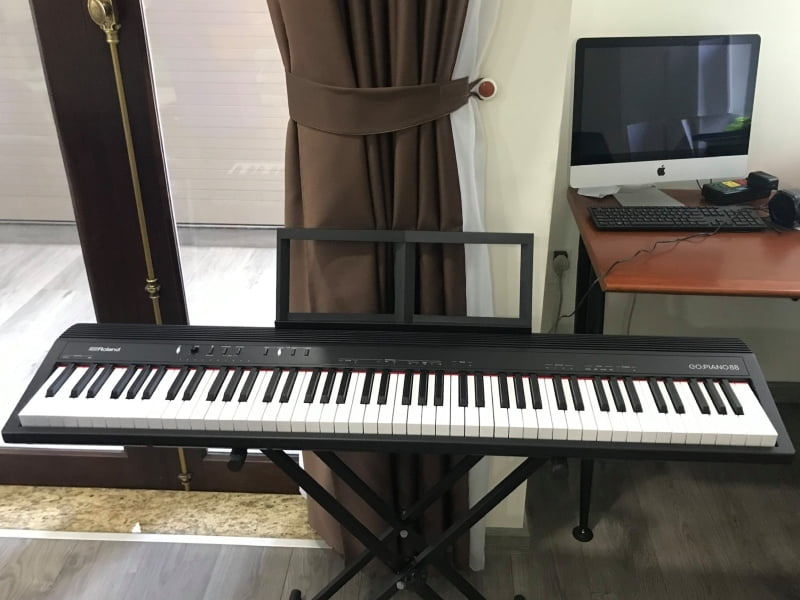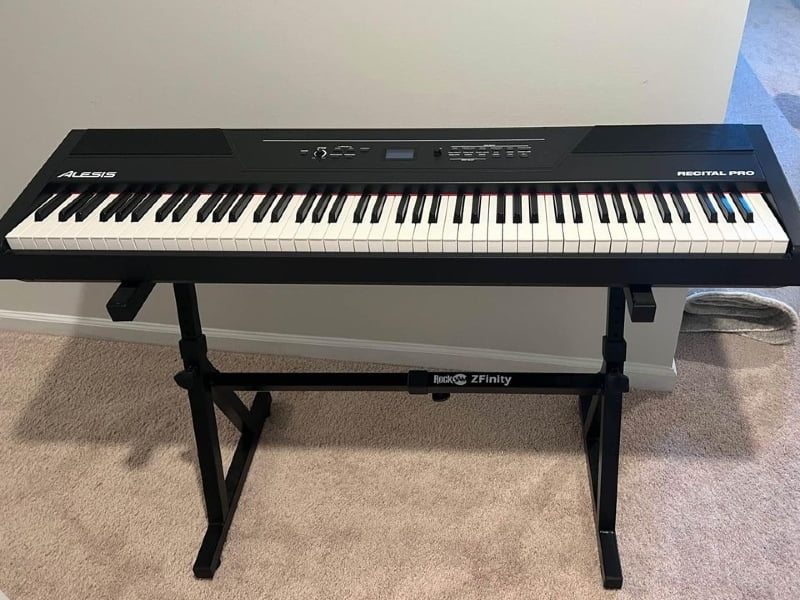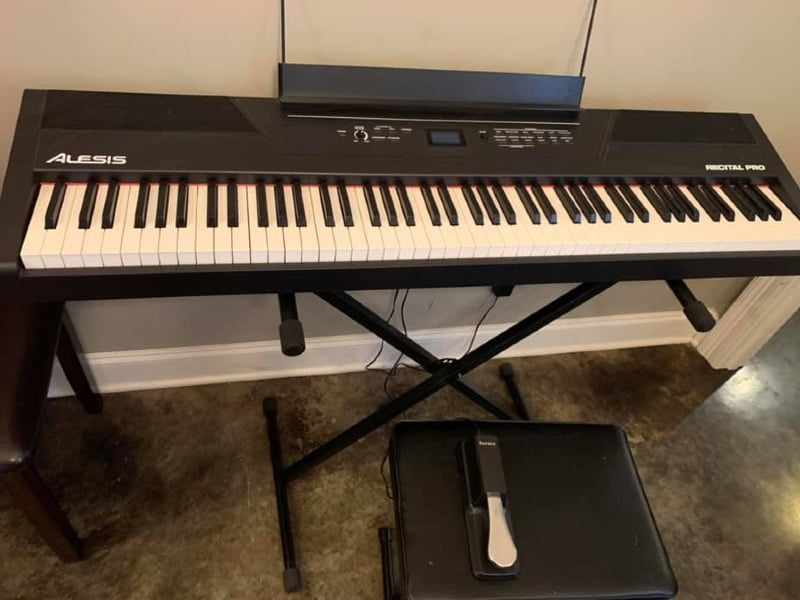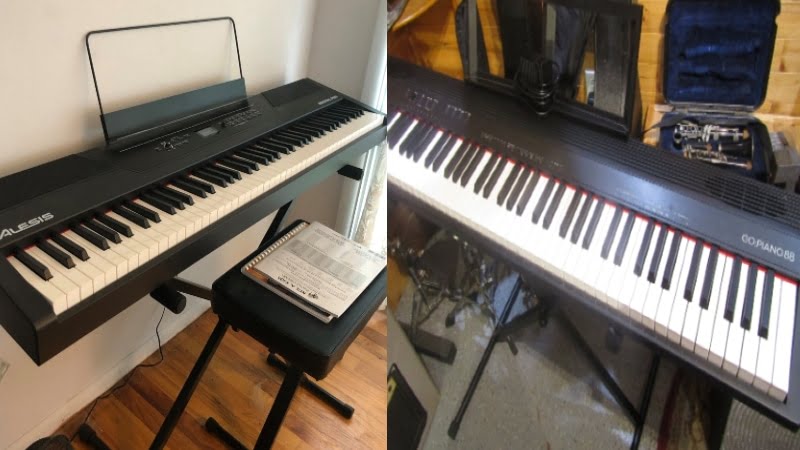The Roland Go Piano 88 has been making waves, but does it compete with the Alesis Recital Pro? Find out in this Alesis Recital Pro vs Roland Go: Piano 88 Review.
Roland is no stranger to the world of digital pianos, and one model that’s been capturing many people’s attention is the Roland Go: Piano 88. This is a full 88-key digital piano that’s part of Roland’s budget-friendly collection of great that’s been exceeding its price range’s expectations.
But to test if this is really the best budget-friendly digital piano on the market, I compared it to the Alesis Recital Pro. In the piano community, this model is known to offer some of the best value for the money and compete with models that are almost twice the price.
So, how did my Alesis Recital Pro vs Roland Go: Piano 88 comparison go?
Well, the Alesis Recital Pro ended up winning by a considerable margin. It comes with a wider sound library, better hammer action, and more playing modes to help you on your musical journey. And while the Roland Go: Piano 88 is still a great model, it couldn’t beat out one of the kings of the budget-friendly digital piano world.
In the rest of this review, I’ll dive into the fine details of my comparison so you will learn exactly how the Alesis Recital Pro beats out the Roland: Go Piano 88.
Alesis Recital Pro vs Roland Go Piano 88: Comparison Chart




Last update on 2025-04-14 / Affiliate links / Images from Amazon Product Advertising API
Alesis Recital Pro vs Roland Go Piano 88: A Head-to-Head Comparison
I decided to compare these piano based on three categories: feel, tone, and additional piano features. And since the Alesis Recital Pro offers one of the best feature sets for any piano in this range, it took all the points. By the end of this review, the score was 3-0 in favor of the Alesis Recital Pro, so I had no choice but to declare it the winner.
Keep reading to learn more about the features of both pianos and why the Roland Go: Piano 88 fell short despite having massive potential.
Feel & Playability
The winner: Alesis Recital Pro
The Alesis Recital Pro was always going to be the winner in this category. This is because the Alesis model actually comes with weighted keys. It’s very important that your digital piano does a good job of replicating the feel of an acoustic piano, and the Alesis Recital Pro does that much better than the Roland Go: Piano 88.

+Hammer Action
Let’s start by addressing the elephant in the room: the Roland Go: Piano 88 has non-weighted keys. This was probably done to cut costs, but I was left disappointed by this feature. While the Roland Go: Piano 88’s keys will respond to how much pressure you put on them, meaning that you can play louder notes by pressing harder, the keys feel very synthetic. Granted, the keys have a bit more resistance than a typical keyboard synthesizer or MIDI controller, but they don’t compare to those on the Alesis Recital Pro.
The Recital Pro is one of the most affordable pianos you’ll find that comes with fully-weighted keys. This is probably one of the highlights of the piano, as it does a great job of replicating how an acoustic piano feels. My one complaint is that the hammer action is uniform and doesn’t capture the subtle differences in the weight of an acoustic piano’s keys.
But this is one of the best hammer action systems available for the price. So, the Alesis Recital Pro is for you if you’re looking for an affordable digital piano with a realistic feel. And if hammer action isn’t a big deal for you, the Roland piano would still be a decent option.
Tone
The winner: Alesis Recital Pro
The next comparison point was the tone. And right away, I figured the Alesis Recital Pro would win. Even if the Roland Go: Piano 88 has fairly realistic voices, the Alesis Recital Pro easily beat it in terms of tonal quality and variety.
+Tone Generation
Both the Alesis Recital Pro and the Roland Go: Piano 88 use samples for their tones. Basically, this means that the pianos are loaded with high-quality recordings of real instruments. And whenever someone presses a key, they trigger one or more of these samples, producing a note.
Between the two, finding a winner based on sound quality alone was hard. When I did an ear test, I found that the Alesis’ tones were slightly more realistic, but not by that much. Both of the pianos were able to produce fairly realistic tones that exceeded the price range’s expectations.
However, the Roland Go: Piano 88 has a very limited sound library which cost it the point. And in the next section, I’ll explain that a bit more.

+Sound Library
When I say you only get the basic voices on the Roland, I mean it. This piano only comes with four different voices. You have one acoustic piano, electric piano, organ, and strings voice. While these are the essentials that most pianists need, it’s definitely limited and doesn’t offer much variety.
On the other hand, the Alesis Recital Pro has 12 different voices. While the voices fall under the same categories as the voices on the Roland, you have more choices in each category. This is great for pianists that are particular about their tone, as it allows you to find the voice that perfectly suits the music you’re playing.
Generally, I recommend that beginners get pianos with fewer tones. However, the Roland doesn’t offer that much variety, even if it has the basics. So, if you’re a beginner, you will benefit greatly from the combination of simplicity and variety in the Recital Pro’s sound library.
Piano Features
The winner: Alesis Recital Pro
Lastly, I looked at the piano features. And yet again, the Alesis came out on top. With more playing modes than the Roland, it offers much more variety which is why the Alesis Recital Pro was the definitive winner in this comparison.
+Playing Modes
The Alesis Recital Pro gives you dual and duo (twin piano) modes. The dual mode allows you to blend two voices together. For example, you can blend a piano and an organ voice to create a unique sound that better fits the music you play. This is a very useful feature for any pianist and is one of my favorite characteristics of the Alesis Recital Pro.
Duo mode is used for piano lessons and duets. This mode divides the piano into two zones with the exact same voice and tuning. This makes it seem like you have two different pianos, which have many applications if you’re a musician.
The Roland Go: Piano 88 only has one additional mode, which is duo mode. Since this is a beginner’s piano that only has the basic features, it’s understandable. However, this further proves my point that the Roland Go: Piano 88 is severely limited and many features aren‘t available.

Alesis Recital Pro vs Roland Go Piano 88: The Similarities
While these pianos have many differences, they also share some similarities. To start, they have similar designs as they are both full 88-key portable pianos. So, you won’t have a hard time bringing them around with you if you have a gig, jam, or even lessons.
Additionally, these pianos have the same polyphony. With a maximum polyphony of 128-notes, you can be very expressive in your playing. These pianos can sustain notes for a long time, even if you constantly add tones on top of the sustained notes.
Most pianos nowadays have much better polyphony than their predecessors. So, it was nice to see both models live up to modern standards.
And while these are both designed for beginners, remember that you have much more versatility with the Alesis. So, while I found the Roland Go: Piano 88 to be decent, I also found that it couldn’t compete with the Alesis Recital Pro.
Quick Rundown of the Alesis Recital Pro
- A Digital Piano That’s Tailored to You - Feature-packed electric keyboard with 88 premium full-sized weighted hammer action keys with adjustable touch response to suit your preferred playing style
- Premium Sounds - 12 voices (Incl. Acoustic Piano, Electric Piano, Organ, Synth, and Bass), built-in FX: Chorus, Modulation, Reverb, and two built in 20W speakers for clear, room-filling sound
- All The Right Connections - ¼” sustain pedal input (pedal not included), ¼” stereo headphone output for private practice and stereo outputs for connection to speakers / amplifiers
- Play the Keyboard Wherever You Go - Power via the included power adapter or 6 D cell batteries (not included) for professional piano performance anywhere
- Powerful Educational Features - Standard, split, layer, record and lesson modes with 128-note max polyphony and Skoove 3 month premium subscription for expert interactive online piano lessons
Last update on 2025-04-14 / Affiliate links / Images from Amazon Product Advertising API
Quick Rundown of the Roland Go Piano 88
- Premium piano performance in a compact, portable and affordable instrument
- 88-note keyboard with full-size keys and standard spacing includes piano tone with 128-voice polyphony
- Onboard high-quality Bluetooth speakers for wireless smartphone connection. Includes sustain pedal, power adaptor, and music rest
- Compact and lightweight for playing and storing anywhere
- Fully wireless operation with battery power and Bluetooth connectivity
Last update on 2025-04-14 / Affiliate links / Images from Amazon Product Advertising API
Product Videos
Related Articles to Alesis Recital Pro
- Alesis Recital Pro vs Williams Legato III: Discover the Best Piano for Your Home
- Alesis Recital Pro vs Yamaha NP32 Comparison: Discover the Best Piano for Your Home
- Kawai ES110 Vs Alesis Recital Pro: Should You Shell Out for the Kawai ES110?
- Alesis Recital Pro vs Prestige Comparison: Choosing the Best Entry-Level Alesis Piano
- Alesis Recital Pro vs Casio CDP-135: Which Is the Best Beginner’s Digital Piano?
- Alesis Recital Pro vs Roland FP-30: Finding the Best Digital Piano on a Budget
- Alesis Recital Pro vs Casio CDP-S150 Comparison: Which Is The Best Portable Digital Piano?
- Alesis Virtue vs Recital Pro: Which Piano Offers The Most For Beginners?
- Alesis Recital Pro vs Casio PX 160: Which Piano Comes Out On Top?
- Alesis Recital Pro vs Roland FP 10: Why You Should Go For The Alesis Recital Pro
- Alesis Recital Pro vs Korg B2 Comparison: Which Digital Piano Should You Get?
- Alesis Recital Pro vs Williams Allegro 3 Comparison: Which One Is Worth Your Money?
- Alesis Recital Pro vs Yamaha P125 Comparison: Which Is The Best Portable Digital Piano?
- Alesis Recital vs Alesis Recital Pro: Should You Invest In The Recital Pro?
- Alesis Recital Pro vs Yamaha P45: Which Should You Get As Your First Piano?
- Donner DEP-20 vs Alesis Recital Pro Comparison: Two Great Pianos Designed for Beginners
- Alesis Prestige Artist vs Recital Pro: Which Is the Best Alesis Piano for Beginners?
- Yamaha P71 vs Alesis Recital Pro: Which Digital Piano is the Best Option for Beginners?
References:
- Alesis Recital Pro: https://www.alesis.com/products/view/recital-pro
- Roland Go Piano 88: https://www.roland.com/global/products/gopiano_go-88p/specifications/
Lulacruza is an electronic folk duo operating at the junction of the hypermodern and the ancient. Our music weaves together hypnotic female singing, South American folk instruments and electronic processing, while channeling pulsating waves from the source of creation.
Lalucruza is also a community where you can connect with other music lovers to collaborate, exchange ideas and share knowledge. A platform for who wants to learns the basics of playing piano, guitar, drum masters’ technique, etc.. is the premise of our website.
